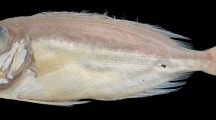Synopsis
The longnose filefish (Monacanthidae, Oxymonacanthus longirostris) was studied at a patch reef on Enewetak Atoll. It swims with undulations of its median fins and feeds almost continuously on coral polyps, using its beak-like mouth. The spot in the tail resembles an eye so that the tail looks like a head when it protrudes from the coral during feeding. There is slight dichromatism in that males have brighter pelvic flaps. Most of the fish were color tagged for individual recognition. They tended to remain within a given area, although some fish roamed throughout the patch. Most of the larger adults formed monogamous pairs; the smaller fish were variously alone or in groups of 1–5 individuals who appeared to know one another. Only pairs having the largest males, on the periphery of the patch, were clearly territorial. Aggression was a common event featuring a few distinctive displays, most of which were used in courtship as well. Spawning may be a daily event, occurring around 1600 h. The female probes and selects a tuft of blue-green algae; the male nuzzles the female and they spawn in the algae. The green eggs are about 0.7 mm in diameter, demersal, adhesive, and hidden in the algae; they hatched in 53.5 h, just after sunset. The planktonic larvae fit the monacanthid type B of Leis & Rennis (1983) and were initially 2.5 mm TL; by day 5 their yolk was gone.
Similar content being viewed by others
References cited
Aboussouan, A. & J.M. Leis. 1984. Balistoidei: Development. Amer. Soc. Ichth. Herp., Spec. Publ. (1): 450–459.
Altmann, J. 1974. Observational study of behavior: Sampling methods. Behaviour 49: 227–267.
Barlow, G.W. 1977. Modal action patterns. pp. 98–134. In: T.A. Sebeok(ed.) How Animals Communicate. Indiana University Press, Bloomington.
Barlow, G.W. 1981. Patterns of parental investment, dispersal and size among coral-reef fishes. Env. Biol. Fish. 6: 65–85.
Barlow, G.W. 1984. Patterns of monogamy among teleost fishes. Arch. Fisch. Wiss. 35: 75–123.
Barlow, G.W. 1985. Review of ‘Reproduction in reef fishes’, by R.E. Thresher. Trans. Amer. Fish. Soc. 114: 314–315.
Barlow, G. W. 1986. A comparison of monogamy among freshwater and coral-reef fishes. Proc. 2nd Internat. Conf. Indo-Pac. Fish., Tokyo: 767–775.
Clark, E. 1950. Notes on the behavior and morphology of some West Indian plectognath fishes. Zoologica 35: 159–168.
Fischer, E.A. 1980. The relationship between mating system and simultaneous hermaphroditism in the coral reef fish, Hypoplectrus nigricans (Serranidae). Anim. Behav. 28: 620–623.
Fricke, H.-W. 1974. Öko-Etholgie des monagemen Anemonen-fisches Amphiprion bicinctus. Z. Tierpsychol. 36: 429–513.
Leis, J.M. 1984. Tetraodontiformes: Relationships. Amer. Soc. Ichth. Herp., Spec. Publ. (1): 459–463.
Lottrich, V.A. & W.H. Meredith. 1974. A technique and the effectiveness of various acrylic colors for subcutaneous markings of fish. Trans. Amer. Fish. Soc. 103: 140–142.
Masuda, H., C. Araga & J.T. Yoshino. 1975. Coastal fishes of southern Japan. Tokai University Press, Tokyo, 379 pp.
Matsuura, K. 1979. Phylogeny of the superfamily Balistoidea (Pisces: Tetraodontiformes). Hokkaido Univ. Mem. Fac. Fish. 26: 49–169.
McCosker, J.E. 1977. Fright posture of the plesiopid fish Calloplesiops altivelis: An example of Batesian mimicry. Science 197: 400–401.
Moore, R.E. 1977. Toxins from blue-green algae. BioSci. 27: 797–802.
Robertson, D.R. & S.G. Hoffman. 1977. The roles of female mate choice and predation in the mating systems of some tropical labroid fishes. Z. Tierpsychol. 45: 298–320.
Robertson, D.R., N.V.C. Polunin & K. Leighton. 1979. The behavioral ecology of three Indian Ocean surgeonfishes (Acanthurus lineatus, A. leucosternon and Zebrasoma scopas): Their feeding strategies and social and mating systems. Env. Biol. Fish. 4: 125–170.
Shine, R. 1978. Propagule size and parental care: the ‘safe harbor’ hypothesis. J. Theoret. Biol. 75: 417–424.
Thresher, R.E. 1984. Reproduction in reef fishes. T.F.H. Publications, Neptune City, New Jersey, 399 pp.
Thresher, R.E. & J.T. Moyer. 1983. Male success, courtship complexity and patterns of sexual selection in three congeneric species of sexually monochromatic and dichromatic damselfishes (Pisces: Pomacentridae). Anim. Behav. 31: 113–127.
Winterbottom, R. 1974. The familial phylogeny of the Tetraodontiformes (Acanthopterygii: Pisces) as evidenced by their comparative myology. Smithson. Contrib. Zool. (155).
Author information
Authors and Affiliations
Rights and permissions
About this article
Cite this article
Barlow, G.W. Spawning, eggs and larvae of the longnose filefish Oxymonacanthus longirostris, a monogamous coralivore. Environ Biol Fish 20, 183–194 (1987). https://doi.org/10.1007/BF00004953
Received:
Accepted:
Issue Date:
DOI: https://doi.org/10.1007/BF00004953




